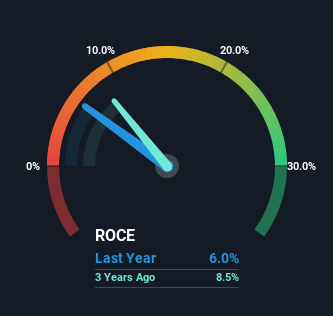- Canada
- /
- Renewable Energy
- /
- TSX:NPI
Northland Power (TSE:NPI) Will Be Hoping To Turn Its Returns On Capital Around
To find a multi-bagger stock, what are the underlying trends we should look for in a business? Amongst other things, we'll want to see two things; firstly, a growing return on capital employed (ROCE) and secondly, an expansion in the company's amount of capital employed. Ultimately, this demonstrates that it's a business that is reinvesting profits at increasing rates of return. However, after briefly looking over the numbers, we don't think Northland Power (TSE:NPI) has the makings of a multi-bagger going forward, but let's have a look at why that may be.
Return On Capital Employed (ROCE): What Is It?
For those that aren't sure what ROCE is, it measures the amount of pre-tax profits a company can generate from the capital employed in its business. To calculate this metric for Northland Power, this is the formula:
Return on Capital Employed = Earnings Before Interest and Tax (EBIT) ÷ (Total Assets - Current Liabilities)
0.06 = CA$781m ÷ (CA$15b - CA$1.6b) (Based on the trailing twelve months to September 2023).
Therefore, Northland Power has an ROCE of 6.0%. In absolute terms, that's a low return, but it's much better than the Renewable Energy industry average of 3.6%.
Check out our latest analysis for Northland Power

In the above chart we have measured Northland Power's prior ROCE against its prior performance, but the future is arguably more important. If you'd like, you can check out the forecasts from the analysts covering Northland Power here for free.
What The Trend Of ROCE Can Tell Us
Unfortunately, the trend isn't great with ROCE falling from 7.9% five years ago, while capital employed has grown 40%. Usually this isn't ideal, but given Northland Power conducted a capital raising before their most recent earnings announcement, that would've likely contributed, at least partially, to the increased capital employed figure. The funds raised likely haven't been put to work yet so it's worth watching what happens in the future with Northland Power's earnings and if they change as a result from the capital raise.
What We Can Learn From Northland Power's ROCE
In summary, Northland Power is reinvesting funds back into the business for growth but unfortunately it looks like sales haven't increased much just yet. Unsurprisingly, the stock has only gained 23% over the last five years, which potentially indicates that investors are accounting for this going forward. Therefore, if you're looking for a multi-bagger, we'd propose looking at other options.
Northland Power does come with some risks though, we found 4 warning signs in our investment analysis, and 1 of those is significant...
While Northland Power may not currently earn the highest returns, we've compiled a list of companies that currently earn more than 25% return on equity. Check out this free list here.
Valuation is complex, but we're here to simplify it.
Discover if Northland Power might be undervalued or overvalued with our detailed analysis, featuring fair value estimates, potential risks, dividends, insider trades, and its financial condition.
Access Free AnalysisHave feedback on this article? Concerned about the content? Get in touch with us directly. Alternatively, email editorial-team (at) simplywallst.com.
This article by Simply Wall St is general in nature. We provide commentary based on historical data and analyst forecasts only using an unbiased methodology and our articles are not intended to be financial advice. It does not constitute a recommendation to buy or sell any stock, and does not take account of your objectives, or your financial situation. We aim to bring you long-term focused analysis driven by fundamental data. Note that our analysis may not factor in the latest price-sensitive company announcements or qualitative material. Simply Wall St has no position in any stocks mentioned.
About TSX:NPI
Northland Power
Operates as a power producer in Canada, the Netherlands, Germany, Colombia, Spain, the United States, and internationally.
Good value with reasonable growth potential.
Similar Companies
Market Insights
Community Narratives



